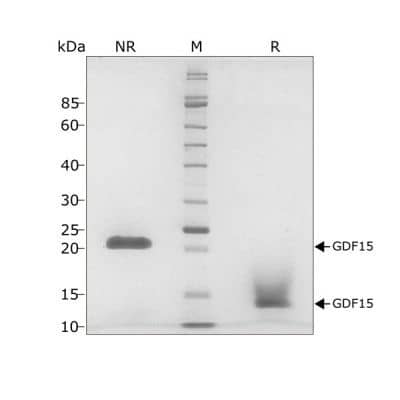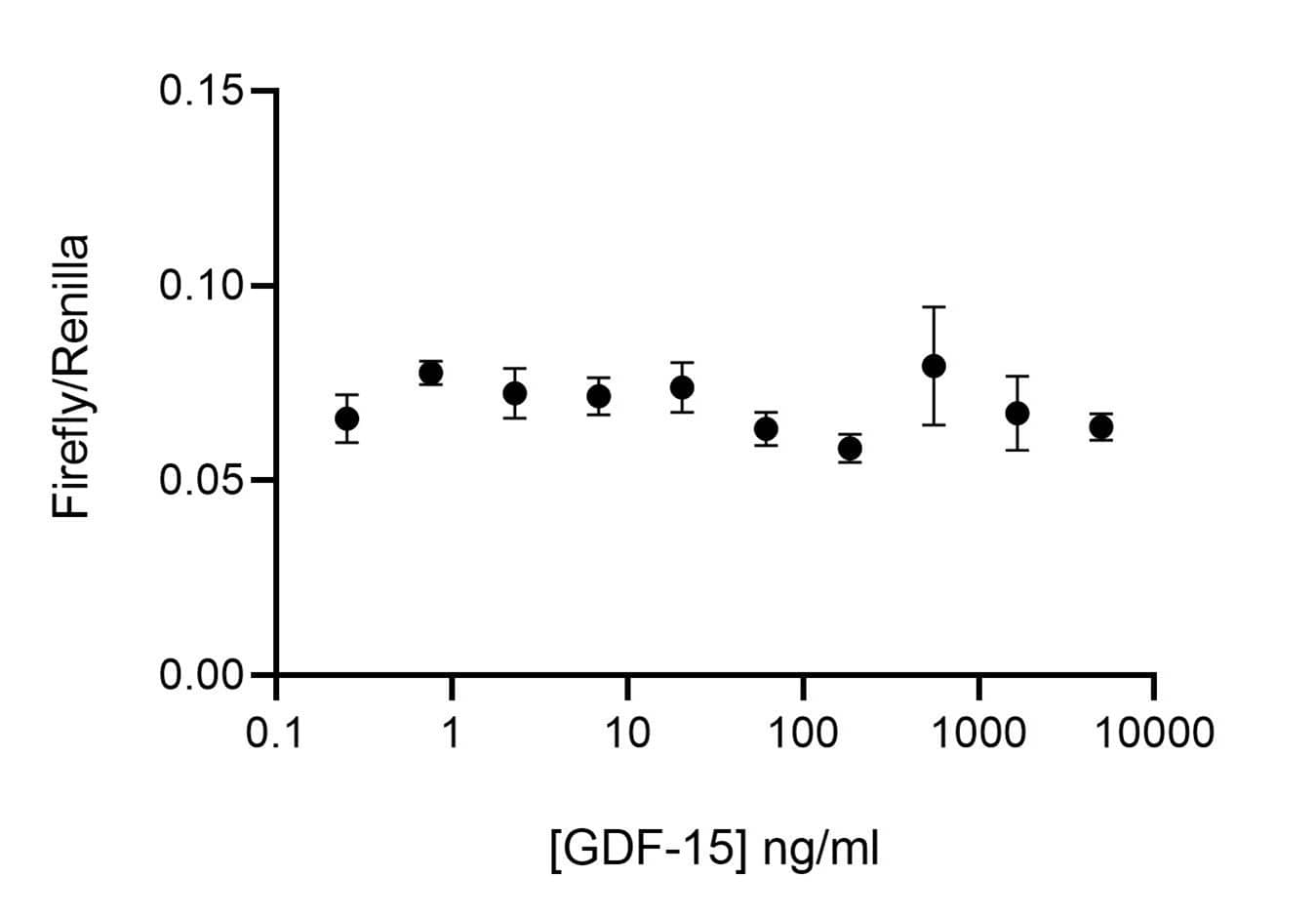Recombinant Human GDF-15, Animal-Free Protein
R&D Systems, part of Bio-Techne | Catalog # Qk017

Key Product Details
Product Specifications
Source
E. coli-derived human GDF-15 protein
Purity
Single species with expected mass
Endotoxin Level
<0.10 EU per 1 μg of the protein by the LAL method.
Predicted Molecular Mass
25 kDa (dimer)
SDS-PAGE
Dimeric GDF-15 protein only
Scientific Data Images for Recombinant Human GDF-15, Animal-Free Protein
Recombinant Human GDF-15, Animal-Free Protein Bioactivity
GDF15 signals through GRAL and co-receptor RET leading to RET phosphorylation and signaling through the ERK and AKT pathway (reviewed in Emmerson et al., 2018). Bioactivity is determined using a luciferase reporter assay in HEK293T cells. Cells are treated (in triplicate) with a serial dilution of GDF15 or Qk010 TGF beta1 for 6 hours. Firefly luciferase activity is measured and normalized to the control Renilla luciferase activity.Recombinant Human GDF-15, Animal-Free Protein SDS-PAGE
GDF15 migrates as a single band at 24 kDa in non-reducing (NR) and 13 kDa as a single monomeric species upon reduction (R). No contaminating protein bands are visible.Purified recombinant protein (7 µg) was resolved using 15% w/v SDS-PAGE in reduced (+ beta-mercaptothanol, R) and non-reduced conditions (NR) and stained with Coomassie Brilliant Blue R250.Formulation, Preparation and Storage
Qk017
| Formulation | Lyophilized from acetonitrile/TFA |
| Reconstitution | Resuspend in 10 mM HCl at >100 µg/ml, prepare single use aliquots, add carrier protein if desired |
| Shipping | The product is shipped lyophilized at ambient temperture, on ice blocks or dry ice. Shipping at ambient temperture does not affect the bioactivity or stability of the protein. Upon reciept, store immediately at the conditions stated below. |
| Stability & Storage | Store lyophilized protein between -20 and -80 °C until the date of expiry. Avoid freeze-thaw cycles. |
Background: GDF-15
References
- Bootcov, M.R. et al. (1997) Proc. Natl. Acad. Sci. USA 94:11514.
- Unsicker, K. et al. (2013) Cytokine Growth Factor Rev. 24:373.
- Bottner, M. et al. (1999) Gene 237:105.
- Fairlie, W.D. et al. (2001) J. Biol. Chem. 276:16911.
- Paralkar, V.M. et al. (1998) J. Biol. Chem. 273:13760.
- Artz, A. et al. (2016) Blood 128:529.
- Johnen, H. et al. (2007) Nat. Med. 13:1333.
- Strelau, J. et al. (2000) J. Neurosci. 20:8597.
- Strelau, J. et al. (2009) J. Neurosci. 29:13640.
- Whitson, R.J. et al. (2013) J. Cell. Biochem. 114:1424.
- Rossaint, J. et al. (2013) J. Thromb. Haemost. 11:335.
- Song, H. et al. (2012) Mol. Biol. Rep. 39:4017.
- Preusch, M.R. et al. (2013) Eur. J. Med. Res. 18:19.
- Kempf, T. et al. (2011) Nat. Med. 17:581.
- Xu, X.-Y. et al. (2014) J. Biol. Chem. 289:10084.
Long Name
Growth Differentiation Factor 15
Alternate Names
GDF15, MIC-1, NAG-1, PDF, PLAB, PTGF-beta
Gene Symbol
GDF15
UniProt
Additional GDF-15 Products
Product Documents for Recombinant Human GDF-15, Animal-Free Protein
Product Specific Notices for Recombinant Human GDF-15, Animal-Free Protein
The above product was manufactured, tested and released by R&D System's contract manufacturer, Qkine Ltd, at 1 Murdoch House, Cambridge, UK, CB5 8HW. The product is for research use only and not for the diagnostic or theraputic use.
For research use only
